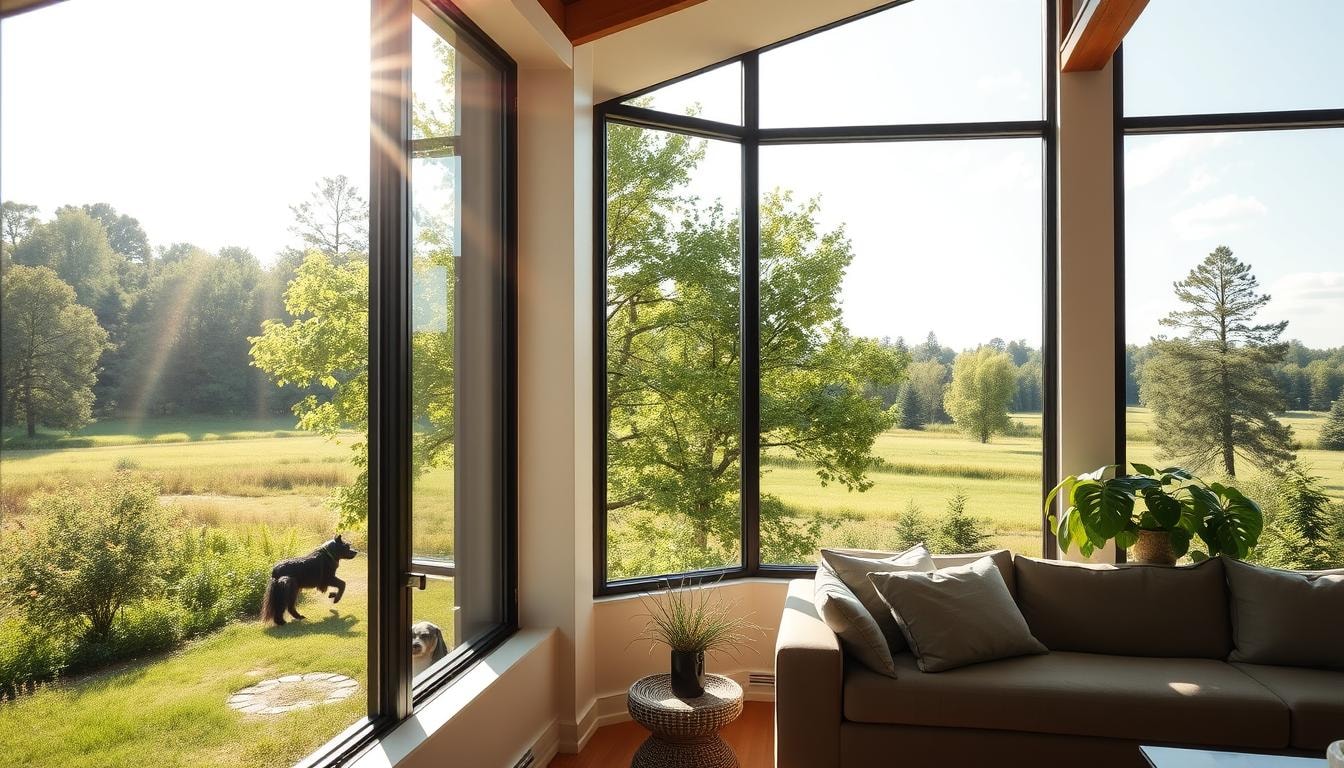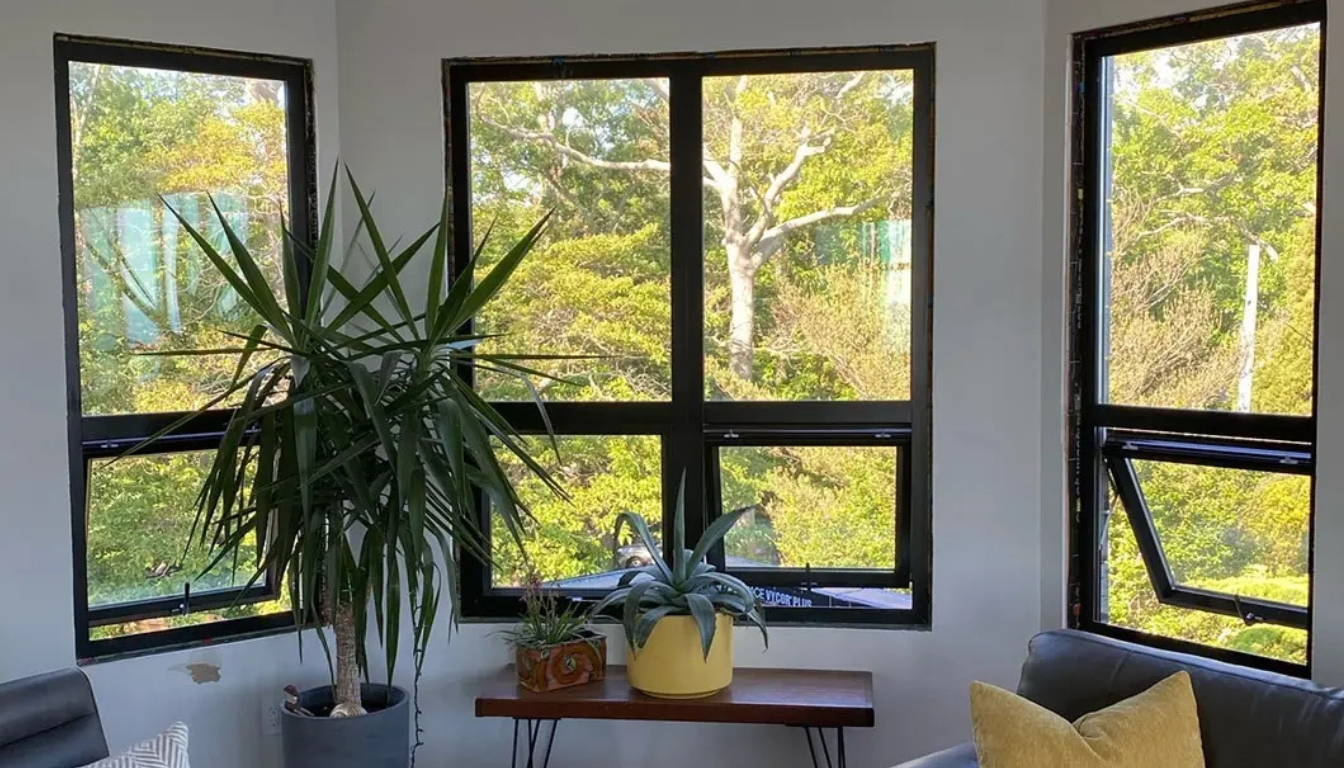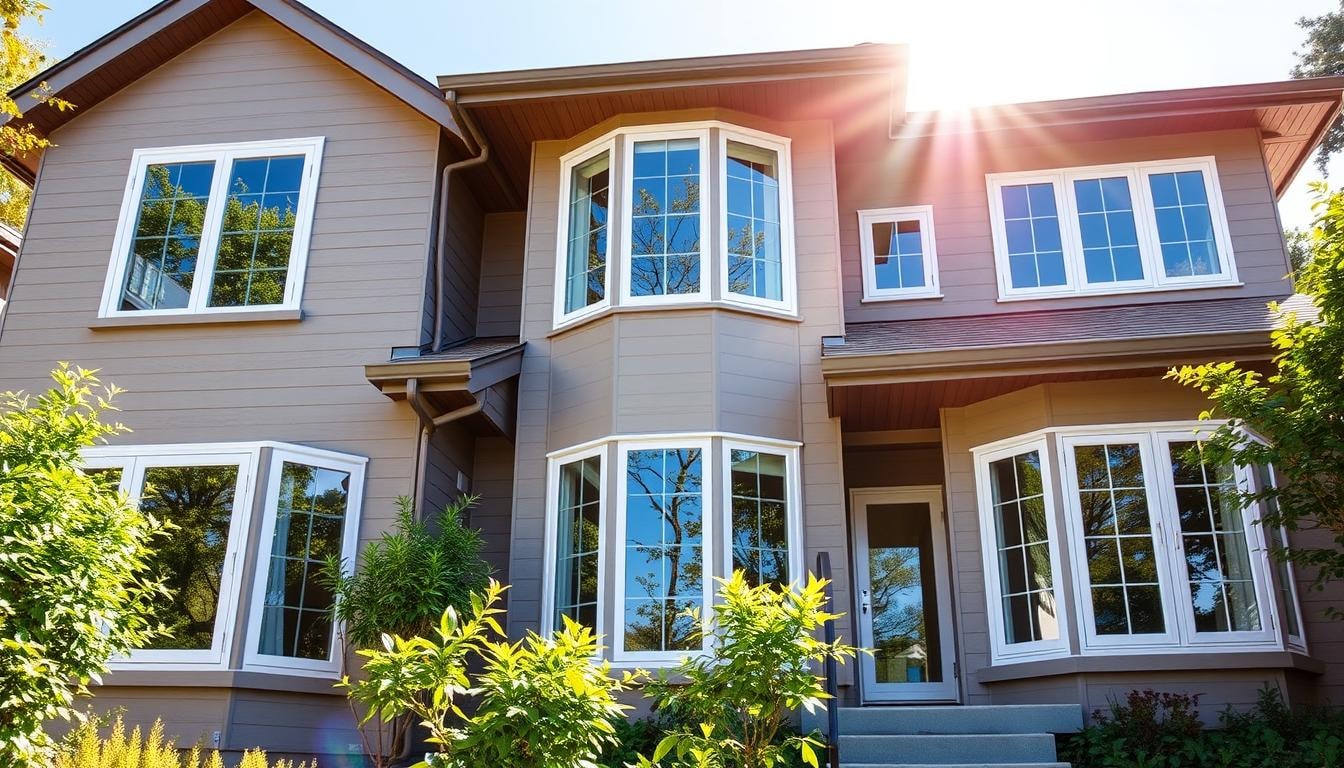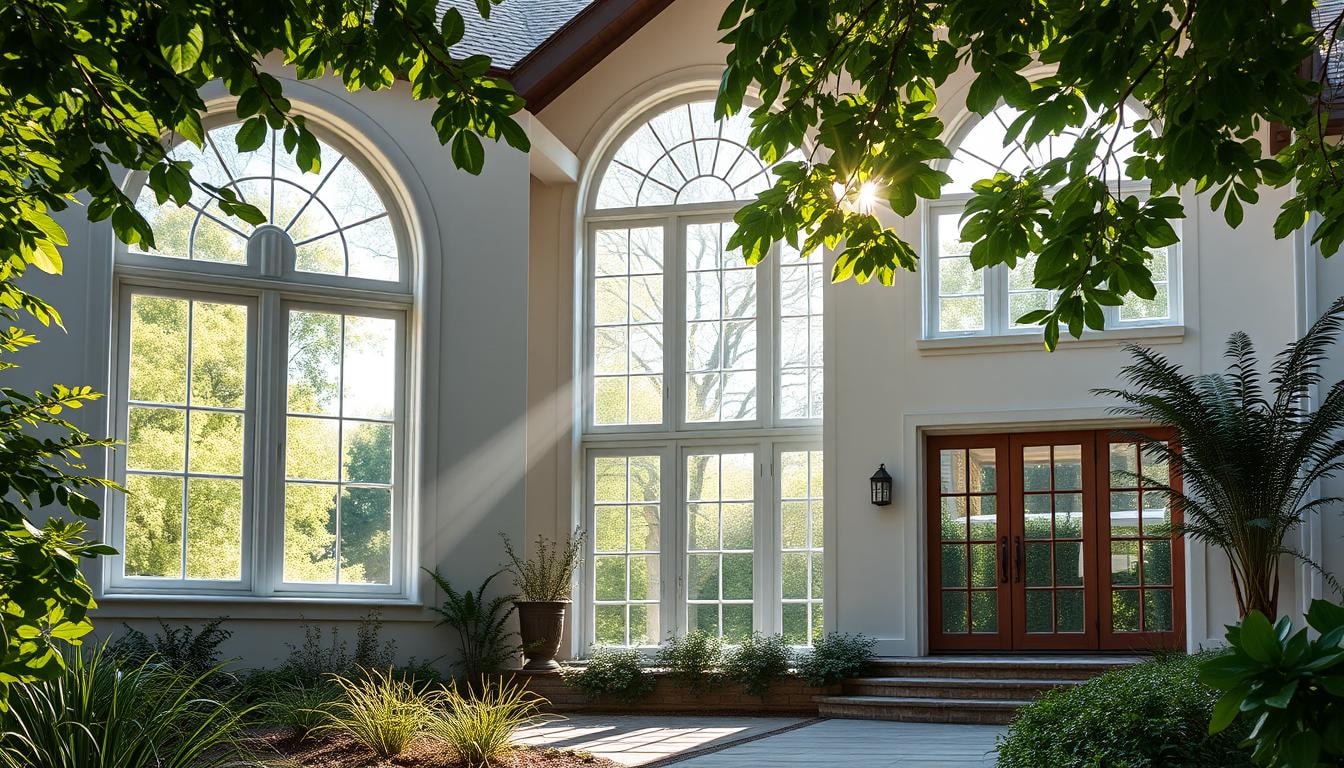
Casement Windows: The Perfect Choice for Your Home
Looking for a window that saves energy, boosts security, and brings in fresh air? Casement windows are your answer. These side-hinged windows open like a door. They’re loved by many homeowners in the U.S. for good reasons.
Casement windows have double or triple-paned glass for top-notch energy saving. They keep your home cool in summer and warm in winter. Plus, they open wide for better air flow. Their modern look fits many home styles, making them a stylish choice.
Key Takeaways
- Casement windows offer superior ventilation and energy efficiency compared to other window types.
- The outward-opening design provides unobstructed views and seamless transitions between indoor and outdoor spaces.
- Casement windows feature a smooth crank mechanism, making them accessible for individuals with limited mobility.
- Casement windows are available in a range of materials, including uPVC, timber, and aluminum, each with its own unique benefits.
- Casement windows can be customized to fit various architectural styles, making them a versatile choice for any home.
Understanding How Casement Windows Work
Casement windows are a favorite for homes. They have a special way of opening and look great. These windows open wide with a crank, letting in lots of air.
Operating Mechanism and Design Features
Casement windows use a crank to open and close. This makes the window swing out smoothly. Without sashes, the glass is clear and adds beauty.
Basic Components of Casement Windows
- Frame: The sturdy frame that holds the window in place and provides structural support.
- Glass: Typically double or triple-paned insulated glass for improved energy efficiency.
- Hinges: The side-mounted hinges that allow the window to swing open and closed.
- Crank Handle: The mechanism used to control the opening and closing of the window.
Different Opening Configurations
Casement windows can open on the left or right. This lets them fit any space perfectly. They open in the best way to let in air.
The Evolution of Casement Window Design
Casement windows have changed a lot over time. They used to be known for their classic look. Now, they offer energy efficiency, better security, and personal style.
The 1950s brought a big change with float glass. This made windows clearer, bigger, and cheaper. It became a key part of casement window design.
In the 1960s, casement windows got even better. Insulating glass units and vinyl frames made them more energy-efficient and affordable. The 1970s saw the start of clad windows, mixing wood’s look with aluminum or vinyl’s strength.
The 1970s oil crisis led to better energy-saving windows. Low-E coatings were introduced to keep windows warmer in winter and cooler in summer. Since then, there have been many more improvements, like impact-resistant glass and smart glass technology.
Now, casement windows work with smart home tech. They can be controlled from afar, saving energy and making life easier. You can choose from wood or vinyl, matching your home’s style.
Today, casement windows are all about saving energy and being eco-friendly. They use Energy Star® and Health Smart™ materials. This shows how casement windows have evolved, blending old charm with new tech.
Superior Energy Efficiency Benefits
Casement windows are known for being very energy efficient. They have tight seals and advanced weatherstripping. This design stops air from leaking, keeping your home warm or cool.
By keeping the temperature inside, casement windows help save money on energy bills over time.
Weatherstripping and Insulation Properties
The energy-saving features of casement windows begin with their weatherstripping. This special seal keeps warm or cool air from getting out. It helps control the temperature inside your home.
The frames and glass of casement windows also offer better insulation than other windows. This makes them more energy efficient.
Temperature Control Capabilities
Casement windows are great at keeping your home at a steady temperature. The U.S. Department of Energy says windows are responsible for 25-30% of heating and cooling energy use.
These windows can cut down energy loss by up to 20% compared to regular windows. This is because of their tight seals.
Cost Savings on Energy Bills
- Energy-efficient windows can cut energy bills by 7-15% according to the U.S. Department of Energy.
- ENERGY STAR certified windows can lower household energy bills by an average of 12% as per the Environmental Protection Agency (EPA).
- The installation of energy-efficient windows can result in annual energy bill savings of 7% to 15%.
By choosing casement windows, homeowners can save money on heating and cooling costs. This leads to big savings on their energy bills over time.
Maximizing Ventilation in Your Home
Keeping your home well-ventilated is key for comfort and health. Casement windows are great for letting in fresh air. They open fully, letting in more breeze than other windows.
Experts say to open windows for at least five minutes a day. Sometimes, they suggest 15-20 minutes for better air flow. Casement windows are perfect for kitchens, bathrooms, and living rooms because they let air move well.
Casement windows can open at different angles. This lets you control the air flow. It’s a smart choice for better air quality in your home.
The Environmental Protection Agency suggests using windows with fans and air filters. Running exhaust fans in kitchens and bathrooms helps remove viruses. This improves the air quality, says the Centers for Disease Control and Prevention.
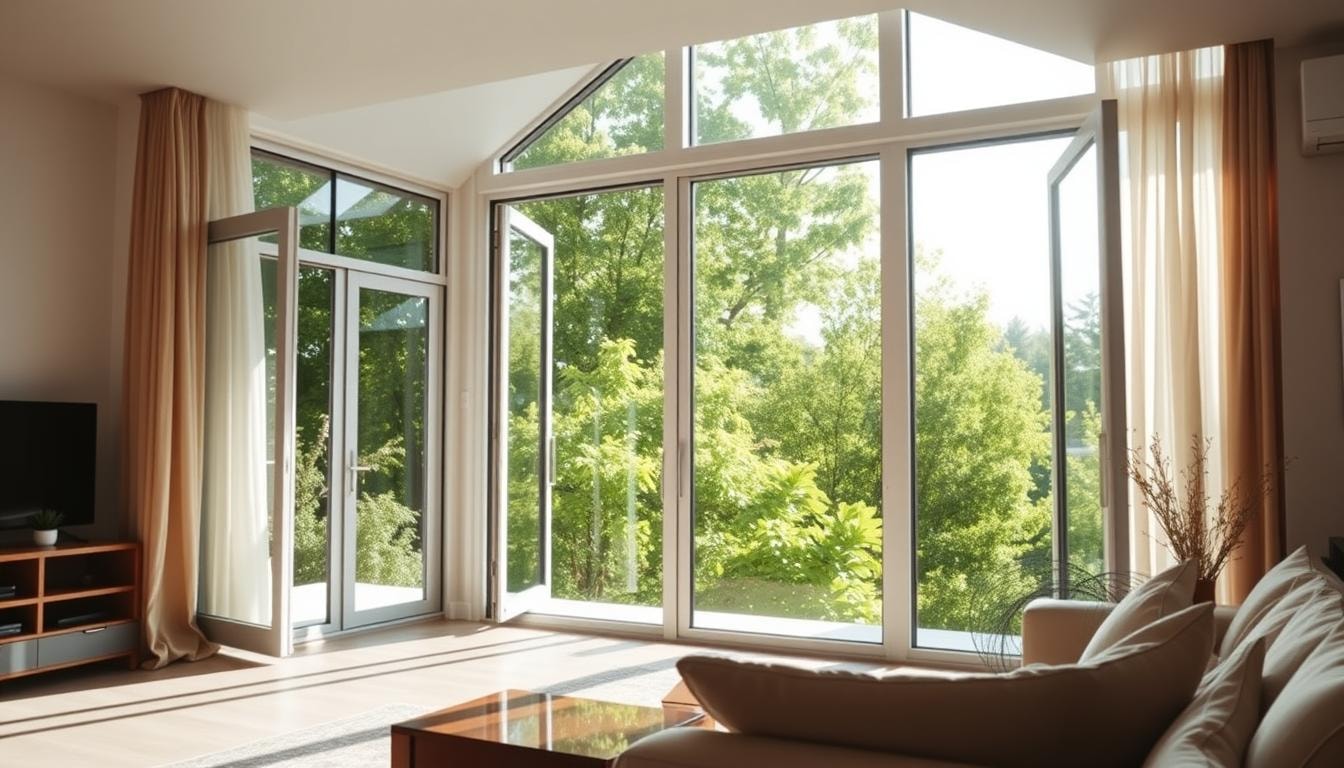
Adding casement windows to your home brings more ventilation and fresh air. It makes your home more comfortable and healthy for your family.
Enhanced Security Features and Durability
Casement windows are a top choice for home security. They have special features that make them stand out. Their built-in locks, shaped like hooks, add extra security. This design helps keep intruders out and makes homeowners feel safe.
The frames of casement windows are strong and made from quality materials. They can handle a lot of force. This means your home stays safe for a long time, protecting your family and things you value.
Long-term Performance Benefits
Casement windows also last a long time and work well. They keep the weather out and help keep your home comfortable. Plus, they don’t need much upkeep. This means your investment in these windows will keep paying off for many years.
In short, casement windows are a great choice for those who want security, durability, and lasting performance. Their strong frames, locks, and weatherproofing make them a solid choice. They give you the security and peace of mind you need for your home.
Casement Window Styles and Customization Options
Casement windows come in many styles. They let homeowners match their windows to their home’s look. You can choose from classic single-sash or modern multi-lite designs.
Popular materials like vinyl, wood, and fiberglass offer different benefits. They vary in durability, energy saving, and looks. You can pick colors to match your home’s decor. Grille patterns and glass types, like decorative or tinted, add to the customization.
- Casement window styles include 1-Lite Right, 1-Lite Left, Fixed, 2-Lite (1/2-1/2), 3-Lite (1/3-1/3-1/3), and 3-Lite (1/4-1/2-1/4)
- Awning window styles feature 1-Lite, 2-Lite (1/2-1/2), 2-Lite (1/3-2/3), and 2-Lite (1/4-3/4) configurations
- Customization options include window colors, decorative or stained glass, privacy glass, tinted glass, and interior grids
With so many styles and choices, finding the right casement windows is easy. They can make your home look better and match its architecture.
Installation Considerations and Requirements
Installing casement windows needs a pro to make sure they work right and save energy. Homeowners must think about a few important things to get the most out of these windows.
Professional Installation Process
Casement windows need special skills to install correctly. Window pros get trained by makers to know how to do it right. They learn how to measure and seal the frames. Trying to do it yourself can cause problems like air leaks and water damage.
Space Requirements and Clearance
Casement windows swing out, so they need enough exterior space to open fully. Homeowners should measure the area well. They must make sure there’s enough clearance for the window, like for shrubs or outdoor lights. This lets the window open fully and let in fresh air.
Structural Considerations
Installing casement windows also means thinking about the house’s structure. Contractors make sure the window openings are strong and won’t sag. This keeps the windows working well for a long time.
Maintenance and Cleaning Guidelines
Keeping your casement windows clean is easy. The inside is simple to reach for cleaning. But, the outside might need a bit more work. Here are some easy steps to keep your windows in great shape:
- Lubricate the hinges every six months or as needed. Use silicone or petroleum-based sprays. They last long and don’t attract dirt.
- Clean the window tracks often. This stops debris from building up and messing with your windows.
- Don’t use harsh or abrasive cleaners. They can harm your windows. Instead, choose mild cleaners made for windows.
- Check the window seals for damage. This keeps your windows energy-efficient and prevents air leaks.
Regular cleaning and upkeep can make your casement windows last longer. They’ll work better too. If you have problems or worries, a pro window specialist can help. They can do a full check and fix any issues.
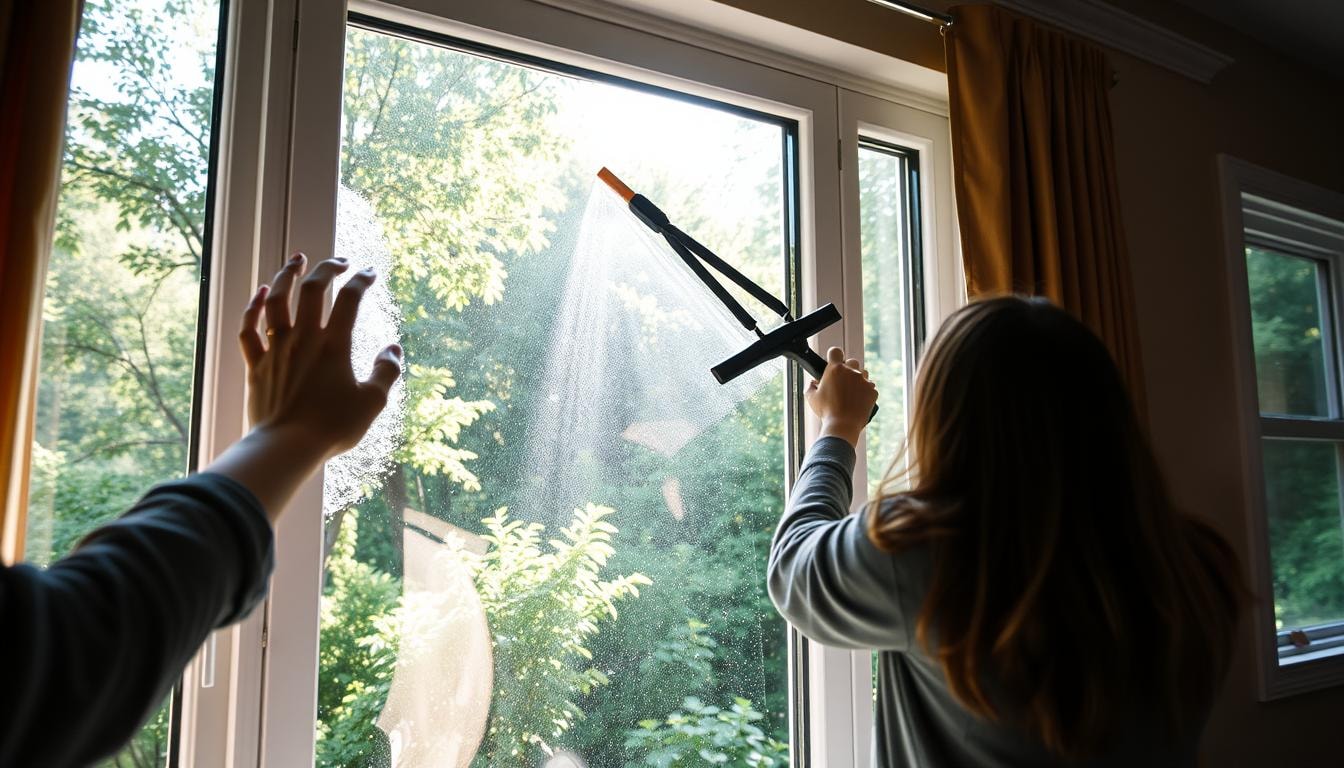
Remember, taking care of your casement windows is important. With a little effort, you’ll enjoy their benefits for many years.
Ideal Locations for Casement Windows
Casement windows are great for many places in a home. They work well in kitchens, bathrooms, and even hard-to-reach spots. They also help make the most of scenic views.
Kitchen and Bathroom Applications
In kitchens, casement windows are a smart pick. They’re easy to open with a crank, even for those who move slowly. This lets in lots of light and air, which is great for cooking.
They’re also good for bathrooms. They offer privacy and better air flow. This helps control humidity and moisture.
Hard-to-Reach Areas
Casement windows are perfect for spots that are hard to get to. Like above sinks or countertops. Their design makes it simple to open and close them, even in tough spots.
This makes them great for bringing in air and light to places that are hard to reach.
Scenic View Optimization
For those who want to enjoy views, casement windows are a top choice. When open, they let you see the outdoors without any blocks. This is perfect for homes with amazing views.
By placing casement windows in kitchens, bathrooms, hard spots, and view areas, homeowners can really benefit. These windows are both useful and beautiful.
Comparing Casement Windows to Other Window Types
Casement windows have special benefits compared to other types like awning, bay, and double-hung windows. Their design lets in lots of air and gives clear views. This makes them a favorite among homeowners.
Unlike double-hung windows, casement windows open by turning a handle. This lets in more air and seals better for energy saving. They also don’t have a middle rail, giving a clearer view.
Bay windows can be big and take up space, but casement windows are sleek and save room. Yet, casement windows might not work well with window air conditioners because of their design.
Awning windows are similar to casement windows in letting in air. But they open from the bottom, giving a different look and function.
Choosing between casement and other windows depends on your needs and home. Knowing the good and bad of each helps you pick the best for your space and style.
Cost Analysis and Investment Value
Casement windows might cost more upfront than other types. But, their energy efficiency and long-term performance make them a smart choice. They can cut down on energy bills over time.
Energy-efficient windows, like those with double-glazed panes, can save a lot of money. They can even increase your home’s value by about $6,700 for every $10,000 spent. Window replacements can also boost your home’s value by 67%.
- Energy Star® certified casement windows can be up to 20% more efficient than standard windows.
- Grants and tax credits may be available to offset the initial cost of energy-efficient window upgrades.
- The choice of window materials and design features can significantly impact long-term cost savings and investment value.
When looking at casement windows, think about the upfront cost and long-term benefits. Energy efficiency and quality matter a lot. This way, you get the most out of your investment.
Contact Budget Windows Today!
If you’re considering new casement windows for your home, Budget Windows is here to help. Our experts offer a wide range of solutions, including vinyl options, hardware, screens, and accessories, tailored to meet your needs.
Whether you’re working on home improvement projects or replacing old windows, we’re ready to assist you. Browse our collection and get in touch with our team for the best advice and products. Secure your home and enjoy the advantages of energy-efficient, easy-to-operate windows today.
Conclusion
Casement windows are a great choice for making your home more comfortable and useful. They save energy, let in lots of air, and look modern. They’re perfect for improving air quality, letting in more natural light, or making your home safer.
Even though casement windows cost more upfront, they save money in the long run. They’re easy to keep up and can even increase your home’s value. Think about what you need, your local weather, and your style to see if casement windows are right for you.
Choosing casement windows means understanding their special benefits. They mix function, energy saving, and style in a way that changes how you enjoy your home. They can make your home more comfortable and beautiful.
FAQs
What are crank windows and how do they work?
Crank windows are casement windows that open and close using a crank mechanism, offering easy operation and providing better ventilation.
Are casement windows hinged on the side?
Yes, casement windows are hinged on the side, allowing them to swing outward for maximum ventilation and a clear view.
Can casement windows be installed in hard-to-reach places?
Yes, casement windows are perfect for hard-to-reach places. Their easy operation via a crank makes them ideal for spots like above cabinets or sinks.
What is the difference between casement windows and traditional windows?
The difference is that casement windows are hinged on the side and swing outward, unlike traditional windows that slide up and down or open in other ways.
Do casement windows offer any advantages in terms of security?
Yes, casement windows are known for their secure operation, featuring sturdy hardware and locks that help keep your home safe.





